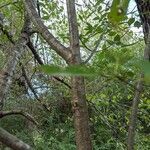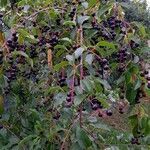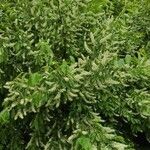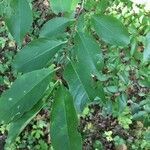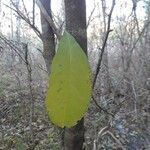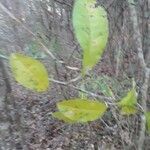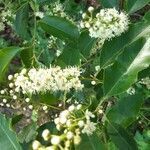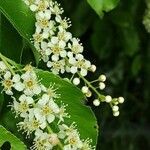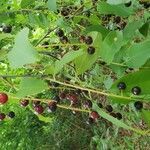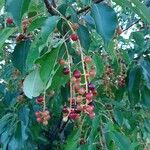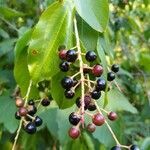Shrubs or trees, not suckering, 40–400 dm, not thorny. Twigs with terminal end buds, glabrous or hairy. Leaves deciduous; petiole 2–23(–30) mm, glabrous or sparsely to densely hairy, usually glandular distally or at petiole-blade junction, glands 1–6; blade usually narrowly elliptic, oblong-elliptic, or obovate, sometimes lanceolate, rarely ovate, 2–13.5 × 1.1–6.5 cm, base cuneate to rounded, margins crenulate-serrulate to serrate, teeth ?incurved or appressed?, sharp or blunt, glandular or callus-tipped, apex usually acute to acuminate, sometimes obtuse, rounded to emarginate in var. alabamensis, ?lateral veins 15–30 per side, flush abaxially?, abaxial surface usually densely hairy along midribs proximally, sometimes glabrous or sparsely hairy, adaxial glabrous. Inflorescences 18–55(–90)-flowered, racemes; central axes (25–)35–160 mm, ?leafy at bases?. Pedicels 1–10 mm, glabrous or hairy. Flowers blooming after leaf emergence; hypanthium cupulate, 1.5–3 mm, glabrous externally; sepals erect-spreading to reflexed, semicircular, 0.5–1.5 mm, margins usually entire, rarely glandular-toothed, ?rarely ciliate?, surfaces glabrous; petals white, obovate to suborbiculate, 2–4 mm; ovaries glabrous. Drupes dark purple to nearly black, globose, 5–10[–25] mm, glabrous; ?hypanthium persistent?; mesocarps fleshy; stones subglobose, not flattened.
More
Tree to 25 m; bark aromatic, breaking up into small plates and appearing scaly-roughened; lvs firm, lanceolate to oblong or oblanceolate, 6–12 cm, with mostly 15 or more pairs of inconspicuous lateral veins, acuminate at the tip, acute or obtuse at base, finely incurved-serrate; racemes terminating leafy twigs of the current season, 8–15 cm; pedicels 3–6 mm; sep oblong or triangular, 1–1.5 mm, entire or sparsely glandular-erose, persistent under the fr; pet white, 4 mm, with subrotund blade; fr dark purple or black, 1 cm thick, edible when fully ripe; 2n=32. Formerly a forest tree, now abundant as a weed-tree of roadsides, waste land, and forest-margins; N.S. to N.D. and sw. Ont., s. to Fla., Ariz., and Guatemala. May.
A medium sized tree. It grows 22-25 m high. The trunk is 60 cm across. The bark is dark grey and smooth. The leaves are sword shaped and 5-15 cm long. They gradually taper to both ends. The upper surface is shiny bright green. It is paler underneath. The teeth are elongated and curve inwards. The flowers are in loose clusters. These are 10-15 cm long. They are at the end of new short, leafy shoots. The fruit are in drooping clusters of 6-12 fruit. The fruit are 8-10 mm across. They are dark reddish-black. They are edible.
The fruit are eaten raw. They are used for jelly and wine. They are also stewed, and used for pies. The bark is the source of an extract used for flavouring drinks, syrups and baked goods. The twigs are used to make a drink. The fruit are also mashed, made into small cakes and dried for later use.
